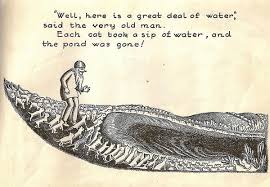Millions of Cats
Listen to the Recess! Clip
| Author | Rita Smith |
| Air Date | 9/10/2003 |

Millions of Cats Transcript
This month marks the 85th anniversary of the publication of Wanda Gag’s wonderful classic children’s book, Millions of Cats. It almost didn’t happen. Gag, who earned a living as an advertising illustrator in New York, had submitted several stories to publishers, only to have them rejected. Frustrated with having to draw to others’ specifications, she quit her paying job and spent the summer in the New England countryside, drawing only the things she wanted to draw in the style she wanted to draw them. On her return to New York in the fall, she had an exhibit of her drawings at a gallery. One of the gallery visitors, Ernestine Evans, the children’s book editor at Coward McCann, asked her to do something for children. She went to her stash of rejected manuscripts, rescued the text and drawings of Millions of Cats, and sent it to Evans.
The story is about a lonely couple who decide they want a cat, so the old man goes looking for one. He travels far away and finally comes to a hill filled with trillions of cats. He can’t decide which one to take home, so he takes them all. Looking at all the cats, the couple decide they will keep the prettiest, and the cats begin to quarrel among themselves about who, indeed, is the prettiest. The quarreling escalates, the fur flies, and in the end only one cat survives, and that is the one the couple raises.
The book was an immediate success. Children loved it. Whether the story is from folklore, or completely made up by Gag is not known, but the text as written is appealing, simple and direct, with wonderful rhythms and that repeated refrain: “Cats here, cats there / Cats and kittens everywhere / Hundreds of cats, / Thousands of cats, / Millions and billions and trillions of cats.” The black and white illustrations compliment and reinforce the text. They are contoured and tightly structured and exude a warm folk art quality.
Evans suggested the long horizontal format of the book (it’s seven inches high and 10 inches wide) and Gag liked that idea because it seemed so appropriate for the journey the old man took and the wide expanse of the pages allowed her to “exploit the full sweep of the double-page spread.1 The illustrations flow over the pages with no borders to constrain them. Gag was, in fact, the first author/artist to spread one picture over two pages, and is credited with reviving the art of the picture book when she published Millions of Cats by managing to fuse text, illustration and format together in perfect harmony.
Notes
1 Hearn, p. 185.
Sources:
Bader, Barbara. American Picturebooks from Noah’s Ark to the Beast Within, New York: McMillan, 1976.
Hearn, Michael Patrick. “Wanda Gag,” in American Writers for Children, 1900-1960 (Dictionary of Literary Biography, v. 22), Detroit, Gale Research Company.